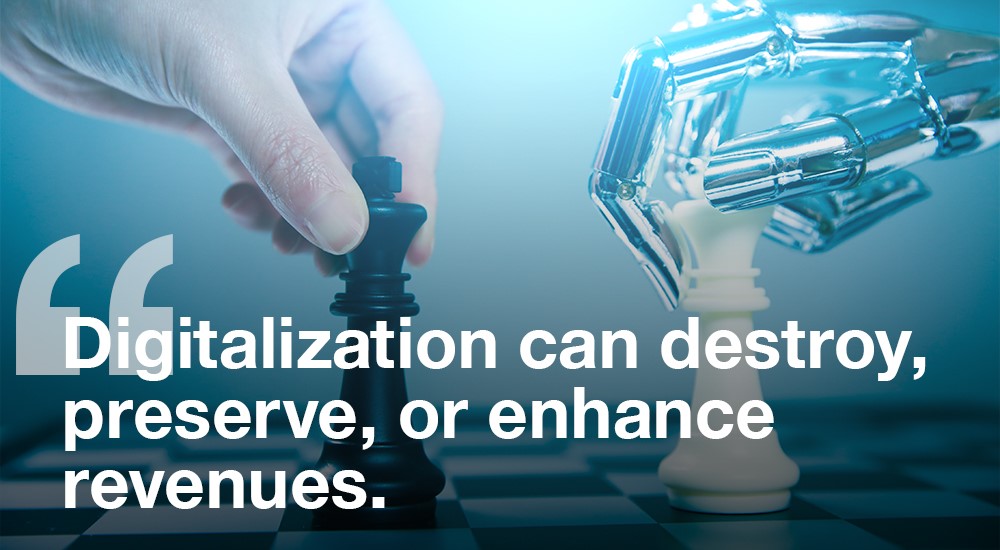Digital transformation is happening everywhere. The world is becoming increasingly digital, and digital technologies are being integrated into all areas of business. In part 5 of our Pricing Basics series, Lisa Jaeger tells us that transformation is a question of survival, and explains what this means for pricing.
To remain competitive, businesses need to keep up with the accelerating pace at which technologies are changing society. Nobody will wait for your business to catch up. Transform or face extinction? Easier said than done. What’s required is an all-encompassing transformation strategy that fully taps into the opportunities that digitalization has to offer.
What is digital transformation?
It’s impossible to give an exact definition of what digital transformation really means, as this transformation looks different for every company. Digital transformation is about more than just the importance and widespread use of technology. Of course, technology is a significant component, but in many cases it is simply the enabler for new opportunities to serve the customer and generate revenues.
What we can definitely can say is that digital transformation is a customer and revenue topic. Digitalization can destroy, preserve, or enhance revenues. It can mean you win or lose customers. What it all means for your company depends on the transformation strategy you put in place.

What causes digital transformation?
Technology plays a critical role, but it is not the only factor. Rather, technology is intertwined with many other developments that spur digital transformation. Here are five of the most important drivers of digital transformation.
1. Innovations are having a bigger impact than ever before
Technologies such as artificial intelligence and the Internet of Things display major transformation and disruption potential. Even physical products are turning digital. In today’s world with Spotify, Netflix and Co, customers can own their music and films without ever holding a physical copy in their hands. Consumers read their newspapers on their digital devices without getting their fingers dirty because of the printing ink. Other physical products are being digitally enhanced, such as smart appliances and wearables, and services are also receiving a digital layer, from online banking to app-placed orders in restaurants. And it is not just about having a fantastic digital innovation. Success means also identifying the right price.
2. New technologies mean new needs
Meanwhile, these new technologies are shaping human behavior and needs. The modern customer has greater expectations of products and services – simple, convenient, easy to use, everywhere and at the touch of a button. On top, more and more customers expect individualized services just tailored to their needs. All of this radically changes how companies deliver value to customers and requires a customer-centric view like never before. That’s why enhancing customer experience and value pricing are top goals of many digital transformation strategies.
3. New channels and revenue models add to the disruption
Online agents and brokers are entering the scene, and webstores that sell directly to the customer are pushing out the middlemen. Also, producers of daily goods are starting to use Amazon to sell their goods, many in subscription models. Just think of Gillette selling razor blades or diaper subscriptions. But also in the B2B context many existing players are in pursuit of new business models, tapping into new revenue sources or even abandoning their original core business completely.
4. Companies unite and form modern ecosystems
Alongside modern technology, the modern channel, and the modern customer, there is another important strand in the maze: modern ecosystems. To best serve demanding customers via multiple channels and with state-of-the-art technologies, we’re seeing a lot more collaboration between companies, and not just between startups and technology businesses. Companies with diverse backgrounds are joining forces, moving away from outdated processes, and revolutionizing their business models as they try to keep up with this rapid pace of digital change. One example from the media industry is the Blender-Nasa collaboration. The free open source 3D creation suite, usually used by professional filmmakers, entered a partnership with NASA and collaborated on their Experience Curiosity Project. Together they developed an app that allows the public to explore Mars via NASA’s Curiosity Rover. Thanks to NASA’s exploration mission and Blender’s 3D technology, users can even control the vehicle’s cameras, move the robotic arm, and take a selfie!
5. Information becomes the product
Finally, modern technologies also enable more efficient and effective processes within the business itself, from recruitment and administration to marketing and customer service. Often there is need to adapt or replace existing technological infrastructure to pursue or accelerate digital transformation, and most transformation activities involve the innovative use of data, such as analytics and machine learning. It’s normal for pricing decisions today to be guided by software. Moreover, “reading” the data and drawing the right conclusions leads to new business assets: it’s becoming increasingly possible to profit from the “intangible”.
In short: digital transformation is all about how technologies change business models, consumer and customer behavior, competitive landscapes, value propositions, data availability, organizational capabilities, and more. All of these changes are not happening in any particular order, but rather all at once, so it’s easy to get lost in the maze when embarking on your digital transformation journey. It’s like “globalization” or “the internet”. It affects everything and anything, but in different ways. There is no one-size-fits-all approach.
How long will digital transformation take?
Many underestimate how hard and how long digital transformation takes. It is about a new way of working, not just one project. It includes many components and intermediate goals, and involves uncertainties, changes, and risks. It also means delivering value to your business and its customers in new and unexpected ways. Efforts often run into roadblocks due to confusion, resistance to change, outdated tools, or unrealistic expectations. Digital transformation is a major challenge and a fantastic opportunity at the same time: it all can’t happen overnight. But it will happen, with or without you.
Where does digital transformation happen?
At the core of your business. Corporate culture and business processes are equally as important to the success of digital transformation strategies as improvements made on the customer-facing side. Everyone needs to be open to ongoing transformation and willing to leave outdated, ineffective processes behind. This often requires a radical change in mindset, and needs clear direction from the CEO. Acquiring the new processes and tools is only the first step. The next challenge is ensuring the entire company is able to work well with this new approach including more customer centricity and technology, and that different departments collaborate. There needs to be adequate funding and oversight while the workforce adjusts.
What makes digital transformation a success?
Digital transformation requires a new way of thinking: From selling products to developing customer relationships. Moving to this customer-centric approach might mean overhauling your entire organization. Are you using new technologies to develop persistent, one-on-one relationships your customers, to understand their evolving needs, and to deliver and monetize the highest value products and services in a customized way? If you can answer all of these questions with a yes, then your transformation efforts will be reflected in your top line.
Enjoyed reading our article? Good news: This popular series is available as A Practical Guide to Pricing! Download our free eBook now and learn how to achieve a sustainable, competitive advantage through pricing!
Read more from our expert blog series Pricing Basics:
Part 1: The Importance of Pricing
Part 2: Pricing Power, and How You Can Profit From It
Part 3: Why Prices End in 99… and Other Psychological Pricing Tactics
Part 4: Value Pricing Changes the Rules of the Game
Part 6: Price increase? No problem. Preparation beats price pressure!
Part 7: Stay Strong – How to Fight a Price War
Part 8: Skimming or penetration pricing?

